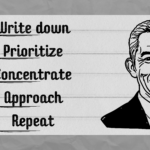Have you ever sat through a team meeting and thought it was a total waste of time?
Yeah, me too. But guess what? Meetings don’t have to be the workplace equivalent of a root canal. Meetings have the potential to be powerful and productive… if you do them right.
Harvard Business Review found that 71% of senior managers view meetings as unproductive. And they are usually the ones running the meetings! The other 29% were probably too busy thinking about lunch to answer the survey.
That’s a lot of wasted time, potential, and coffee!
The same HBR study found that business executives spend around 23 hours weekly in meetings, compared to less than 10 hours in the 1960s. And most of those meetings could’ve been emails.
We have to change things because far too many people hold poor meetings.
6 Tips To An Engaging Meeting That YOUR Team Might Look Forward To
TIP #1 – SET THE STAGE
Why are we having a meeting? What’s the purpose?
Every meeting must have a central theme, purpose, or point. As Simon Sinek says, “Start with why.” Are you brainstorming? Are You making decisions? Or are you just touching base? Be crystal clear about this when you send out that invite.
Having a clear purpose for the meeting will also help ensure you invite the right people. Don’t ever invite more people than you absolutely need.
TIP #2 – CREATE AN AGENDA
Don’t wing it. You may be good at riffing, but many people aren’t.
Creating an agenda for a meeting is crucial. It’s like telling your GPS exactly where you want to go. Otherwise, you’re just driving around aimlessly, wondering why you end up at the same Starbucks. Or is that just me?
Also, running a meeting with an agenda will save time and reduce the chance that people will attend the meeting unprepared. Introverts shine when they have an opportunity to prepare beforehand.
A meeting without an agenda is like a road trip without GPS. You might have fun, but you’ll probably get lost. Spend a few minutes jotting down key sections of the meeting and adding time blocks for each section. Research shows that agendas can improve meeting productivity by 20%. Keep it concise and focused, and distribute it beforehand so everyone comes prepared.
TIP #3 – TIME MANAGEMENT
A small business hired me to get their team back on track. In prep for my full-day strategy session with them, I shadowed the managers the day before to understand how the team operated. Even though I was with them for one day, I gained four interesting insights into what keeps meetings on track with time versus going off the rails.
- Always Start on Time: If we start our meetings late, we are training our people that it’s ok to be late because it always starts late. If we start our meetings on time, we train our people to be on time because it always starts on time. So even if half the room isn’t there, start your meeting on time. It might be rough for the first few meetings because your team needs to be retrained so that you start meetings on time.
- Odd Meeting Times: Managers who set odd meeting times like 10:10 or 11:50 seemed to start on time more than managers who did the regular meeting times. Nothing says ‘we mean business’ like starting a meeting at a time that looks like a football formation. Ten. Ten. Blue. Forty. Two. Hike!
- Time Driver: Someone, usually the leader of the meeting, needs to keep track of the time between each meeting section. If no one is the time driver for the meeting, the meetings always run long. But when there was a time driver, they usually ended on time.
- Ending On Time: The most productive meetings I sat through ended on time. While my data for this claim is qualitative based on my experience, I saw it happen repeatedly in the meetings. Awareness of how much time was left caused people to be more effective during the meeting.
TIP #4 – UP THE ENGAGEMENT
You invited these people to the meeting, so why did you invite them in the first place if they just sit there and don’t participate? Also, you are missing out on hearing diverse perspectives by not hearing from everyone, which can bring fresh new ideas. If your people aren’t participating in the meeting, here are three suggestions I have for you:
- Model great engagement: Your team will never show a higher level of engagement than you. Nothing screams ‘I’m not interested’ like nodding while you discreetly check your fantasy football scores under the table. You have to lead by example. Show your team what active engagement looks like. Listen attentively, ask insightful questions, and provide thoughtful feedback. Create a welcoming atmosphere where everyone feels comfortable sharing their ideas. A quick way to shut down a conversation is to make fun of someone for their idea. Acknowledge contributions and show genuine interest in what others have to say.
- Engage the Introverts: Recognize that only some are comfortable speaking up in a group setting. Create an inclusive environment where introverts feel valued and heard. Use techniques like ‘Think-Pair-Share,’ where individuals first think about a question independently, discuss it with a partner, and then share it with the larger group. This approach gives introverts time to formulate their thoughts. Directly but respectfully invite input from quieter members. Sometimes, a simple “I’d love to hear your thoughts on this, [Name]” can encourage participation without putting someone on the spot.
- Include Energizers: Sometimes, people just need a state change because their energy is low. Or they just ate a heavy meatloaf for lunch, and it’s sitting like a brick in their stomach. Keep the energy high with short, relevant energizer activities. This can be as simple as a quick stretch break or a fun, on-topic get-to-know-you question.
If your people aren’t engaged, you can yell at them all day or change yourself and the meeting setup to make engagement much easier and more enjoyable. Engagement isn’t just about speaking up; it’s about creating a space where everyone feels their input is valued and contributes to the meeting’s objectives. By modeling engagement, including all personality types, and incorporating energizers, you create an atmosphere where everyone is motivated to participate actively.
A highly engaged team will produce a great meeting.
TIP #5 – CLEAR ACTION PLAN
As the meeting progresses, it’s natural that things will come up that people have to take action on after the meeting. As these tasks come up, clearly state the action item, when it’s due, and who is responsible for completing it before moving on. This process will probably happen several times throughout the meeting, but don’t let an action item go by without it being clearly stated and assigned; otherwise, it won’t get done.
Without a clear action plan, meeting conclusions are like New Year’s resolutions – forgotten the moment the cookie tray is passed around.
TIP #6 – FOLLOW UP & FOLLOW THROUGH
A meeting’s success can often be judged by what happens after it ends. Before you leave the meeting, here are two things to do to ensure your follow-up and follow-through happen.
If needed, schedule a follow-up meeting before the meeting ends. Once people return to their daily schedule, you’ll have to work 4x as hard to set a date for the next meeting as you will if you do it right there in the room. Just ensure you do this at the end of the meeting because once people open their phones or laptops, they will get overloaded with messages they missed while in the meeting, and you’ll lose their attention. Set a date for follow-up on action items. This ensures accountability and keeps everyone on track. Remember, follow-through is just as important as the meeting itself.
Have someone restate the specific tasks I talked about in Tip #5 that need to be accomplished, by when, and who is responsible. This way, everyone leaves knowing precisely what they need to do.
And there you have it! Now you know what to do to run an effective and efficient meeting. And because I know some of you were ordering lunch while also trying to read this post, here’s a quick recap of the main points to running a successful meeting:
- Set a Clear Purpose: Determine and communicate the ‘why’ of your meeting, ensuring it has a focused objective.
- Craft a Focused Agenda: To keep discussions on track, organize the flow of the meeting with a well-structured agenda.
- Respect Time: Start and end on time, manage the duration of discussions, and try those offbeat meeting times for punctuality.
- Engage Your Team: Encourage active participation, include everyone in the conversation, especially introverts, and use energizers to keep the energy up.
- Follow-Up and Follow-Through: Make sure action items are assigned and followed up on, and if necessary, schedule the next meeting then and there.
Mastering these elements can transform your meetings from time sinks to productive, enjoyable decision-making sessions. Take these tips and run an effective, engaging, and maybe even fun meeting. Go on, make me proud!




